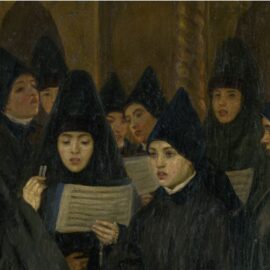

This article is an excerpt from the Shortform book guide to "The Bhagavad Gita" by Eknath Easwaran. Shortform has the world's best summaries and analyses of books you should be reading.
Like this article? Sign up for a free trial here .
What is the ashvattha tree? What role does the ashvattha tree play in The Bhagavad Gita and why does Arjunaa visit it?
The ashvattha tree is a sacred world-tree in Hindu mythology. When people overcome their demonic Gunas, they free themselves and can continue to their true home.
Read more about the ashvattha tree in The Bhagavad Gita below.
Journey to the Ashvattha Tree: Divine and Demonic Tendencies
Before Krishna journeys to the ashvattha tree, he has to learn about karma and what drives people to act. Just like the gunas drive people’s actions, so too do divine and demonic tendencies, and with similar consequences. Krishna says that what he has been explaining so far—detachment, peace, spirituality, and so on—are divine tendencies. People with these tendencies will be reborn into good families who will nurture their spiritual growth and, eventually, they will stop being reincarnated entirely. Arjuna was born with divine qualities.
However, some people exhibit demonic tendencies instead. These people are driven by lust, anger, and greed. They don’t believe in God, spiritual law, or morality. They think that the only source of life is biological—that is, sex—and that life has no purpose except fulfilling their desires.
Since they don’t believe in any higher power, people with demonic tendencies may come to believe that they themselves are godlike. They’ll see their wealth, their social status, and their material accomplishments as proof that they are better than other people. They may talk about how they’ve proven their power by defeating their rivals, or shown their grace and generosity through offerings and charity. They think that they are destined to get everything they want—however, their desires are insatiable, and they always want more and more.
Krishna says that he casts people who are ruled by their lust, anger, and greed into new lives with families who have the same tendencies. Therefore, they get more and more entrapped by their worst impulses, and never free themselves from karma.
Krishna urges Arjuna to renounce lust, anger, and greed, and instead to live his life by the scriptures and by Krishna’s teachings.
Krishna’s Home
Krishna next talks about the ashvattha tree, a sacred world-tree in Hindu mythology and a way of visualizing all the things that keep people bound to karma. The tree is upside-down, with its roots stretching upward into Brahman and its branches spreading through the universe. Sense-objects grow like buds on the limbs of the ashvattha tree. The tree is fed by the gunas, and it keeps people bound to the outcomes of their actions, tangled in its branches, so that they continue experiencing those gunas.
However, though the tree is strong and its roots are deep, Krishna tells Arjuna that he can cut it down with the axe of detachment. As he’s said before, the key is to act without selfish desire or concern for the outcomes of actions. This, like freedom from the gunas and living by divine tendencies, will help Arjuna to avoid reincarnation.
People who are able to overcome the gunas, their demonic tendencies, and free themselves from the Ashvattha tree join Vishnu in his true home, never to be reborn again. Krishna now describes that home, the place where souls who free themselves from samsara end up. He describes it as a place of light; not the light of the sun, the moon, or fire, but the pure light of the true self. And, since all souls come from him, the light is also Krishna himself. Beyond that, his home is beyond language’s ability to describe.

———End of Preview———
Like what you just read? Read the rest of the world's best book summary and analysis of Eknath Easwaran's "The Bhagavad Gita" at Shortform .
Here's what you'll find in our full The Bhagavad Gita summary :
- The key principles of the Hindu faith
- Why all spirituality is good and there is no single path to God
- The 3 reasons that can explain every action people take






